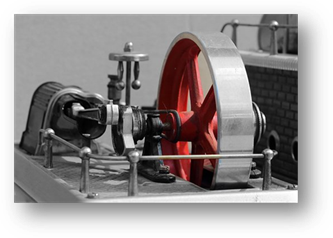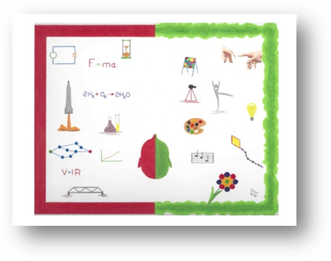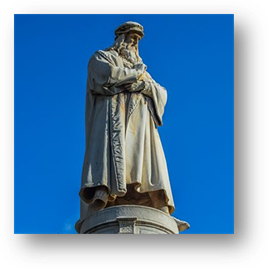|
In 1871, engineer James Watt patented a steam engine that, for the first time, produced continuous rotary motion. Steam engines figuratively and literally drove the Industrial Revolution and introduced the expression “build a head of steam.” When that critical pressure is achieved and applied to pistons, engines begin to move, drive productive devices, and propel load-carrying vehicles.

We should, individually and organizationally, strive to build heads of STEAM by adding “A” for visual or performing arts and, broader yet, humanities, to our already developed knowledge and skills in science, technology, engineering, and mathematics. By embracing the broad and exploratory STEAM mindset, and further engaging both sides of our individual and collective brains, we will enjoy more personal and organizational productivity, innovation, and enhanced service to clients, customers, and stakeholders. “Half a brain is better than none. A whole brain would be better,” according to Betty Edwards author of Drawing on the Right Side of the Brain.

A STEAM perspective gives us a better understanding of how almost everything connects to everything else to the extent that science, technology, engineering, art, and mathematics help us comprehend the increasingly complex world around us. The “everything is connected to everything” realization enables individuals and organizations to be more aware of the consequences of our actions and empowers us to recognize many and varied opportunities.
Exemplars
Leonardo da Vinci set the standard for building a head of STEAM at the individual level. He was a competent scientist, technologist, engineer, artist, and mathematician. As a scientist, he conducted the first documented autopsy and, two centuries before Newton, described the essence of Newton’s first law. The technologist in him conducted experiments and constructed maps and he engineered canals and fortresses. Finally, as an artist and mathematician, he showed artists how to portray three-dimensional effects on a two-dimensional medium.

We probably won’t become da Vinci-type geniuses, but we can see in him the potential power of a whole-brain approach -- the potential of building heads of STEAM in ourselves and others.
More recently, Steve Jobs attributed Apple’s success to combining technology with the arts. “We believe that it’s technology married with the humanities that yields us the result that makes our heart sing,” he said. Within engineering, the late engineer Rich Weingardt’s life illustrates the STEAM mindset in that he was a structural engineer, author, leadership advocate, and artist.
Engineering professor and artist Wendy C. Crone says “The ability to see detail and attend to subtle changes in images is critical to my engineering research” and she believes that “these skills are enhanced by my practice of painting.” According to aeronautical engineer Theodore von Karman, “Scientists explore what is, engineers create what never has been.” Santiago Calatrava, the Spanish engineer, architect, sculptor, and painter, said this about his breadth of perspective, “In my hands, there is a little bit of architecture and engineering.”
Experience and studies show that homogenous teams, such as all STEM or all Arts-oriented individuals, will tend to experience high communication effectiveness and require little time to make decisions but, unfortunately, arrive at results that are low in creativity and innovation. In contrast, heterogeneous teams, such as those comprised of both STEM and Arts members, will take longer to make decisions but arrive at much more creative-innovative results.
STEAM Suggestions
If you agree that we should move to the more effective STEAM mindset, then consider the following suggestions for building heads of STEAM, as individuals and organizations:
- Are you, by virtue of interests and vocation, deeply into STEM? If so, on a whim, enroll in a one-day drawing class or sign up for ballroom dancing lessons. Alternatively, if you have colleagues who are committed Arts persons, urge them to read some science and engineering articles, audit an engineering class, or visit an automobile manufacturing plant.
- If you hold a leadership or management position in a business, government, or other entity, help your personnel understand STEAM and how embracing it could benefit them, your organization, and those you serve. Ask colleagues to share, at “brown bags,” their Art or STEM passions -- you and others will be surprised and inspired by the variety of talents in your midst.
- As a manager in any organization, when you form ad hoc or long-term teams, assemble and charge highly diverse groups – then get out of the way. Expect early communication frustration and later innovative results.
- Does your work place provide a STEAM-compatible culture and physical environment? Culture means the way things really work around here. Frankly, in spite of the creativity and innovation pronouncements of their spokespersons, the physical environments and cultures of most public, business, and academic organizations, intentionally or unintentionally, frustrate or kill creativity and innovation.
- When leading an engineering design effort, engage someone from the Arts community, as a regular or intermittent team member. Explain what you are designing and what it is supposed to do and for whom. Invite them to weigh in during the design process. Because of the artist’s different perspectives, you are likely to receive fresh suggestions about the form and function of the object of your design and/or how to communicate its essence to decision makers and users.
- As an inquisitive person, you have a growth or exploratory -- as opposed to fixed -- mindset. Commit to researching and writing a paper on a subject that bridges from your STEM orientation to the Arts. You will learn how both sides are needed to propel an idea forward.
Notes:
- This article draws on research used to write my 2017 book Introduction to Creativity and Innovation for Engineers.
- I welcome opportunities to speak, teach, conduct workshops, and collaborate about any aspect of helping engineers become even better communicators -- writing, speaking, listening, and using visuals. Contact me at stu-walesh@comcast.net or 219-242-1704.
- Image sources: Pixabay and author
Learn More About Stu Walesh | Clients Served | Testimonials & Reviews
Managing and Leading Books | Tailored Education & Training
Home | Legal Notice | Privacy Statement | Site Map
Copyright © Stuart G. Walesh Ph.D. P.E. Dist.M.ASCE
Web Site Design, Hosting & Maintenance By Catalyst Marketing / Worryfree Websites |

